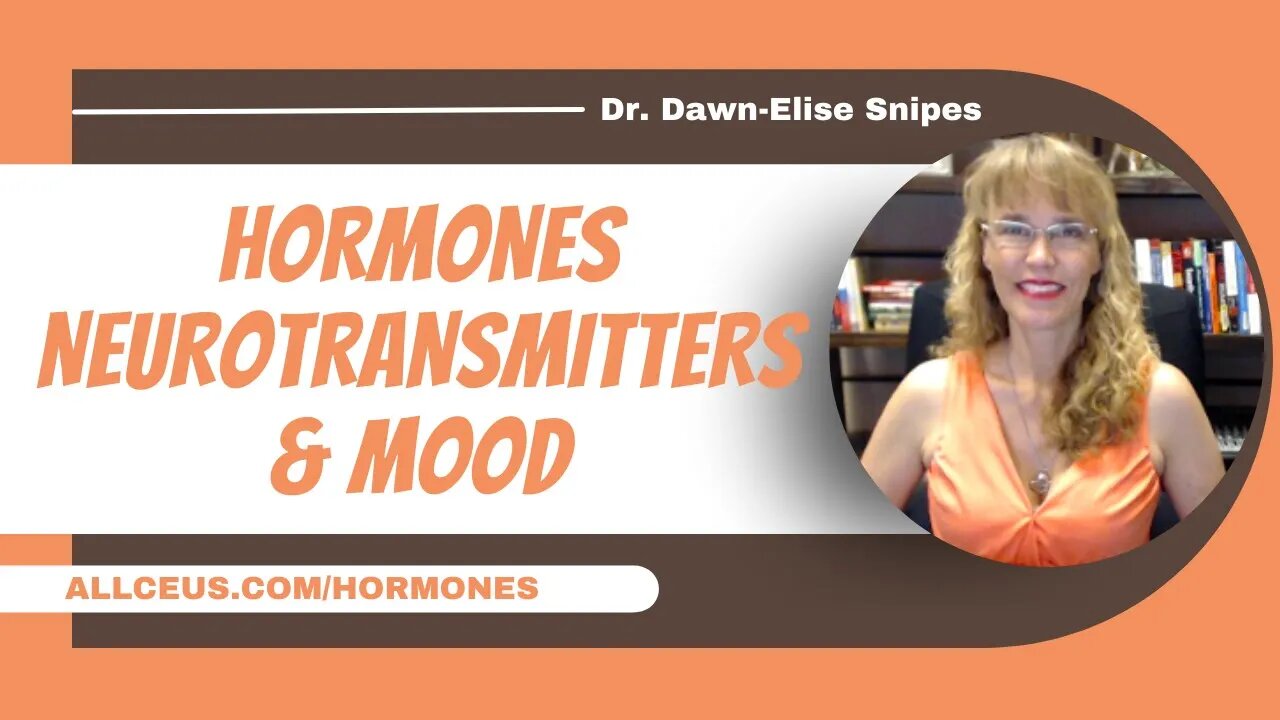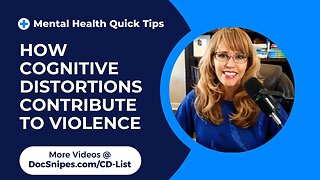Premium Only Content

Interactions of Hormones and Neurotransmitters and Mood
#serotonin #hormones #mentalhealth #neurotransmitters
https://allceus.com/hormones
📢SUBSCRIBE and click the BELL to get notified when new videos are uploaded.
💲 EARN CEUs at: https://www.allceus.com/member/cart/index/product/id/1409/c/
Unlimited CEUs $59 based on these videos at allceus.com for social work, counseling, marriage and family therapy, addiction counseling, case management, pastoral counseling and more.
Join this channel to get access to perks:
https://www.youtube.com/channel/UCAE3JJi8tX7gfhZEXCUGd_A/join
Interactions of Hormones & Neurotransmitters
Dr. Dawn-Elise Snipes
PACER Integrative Behavioral Health
Objectives
~ Review parts of the brain
~ Get a general understanding of the most important hormones and neurotransmitters
~ Serotonin is a neurotransmitter with seven families (5-HT1–5-HT7) and approximately 15 receptor subtypes.
~ Mood
~ Energy and glutamate release
~ Respiration
~ Blood pressure
~ Appetite
~ Pain perception
~ Bone density
~ Memory
~ Learning and cognition
~ Motivation and dopamine release
~ Acetylcholine, dopamine and norepinephrine release in the frontal cortex
~ GI motility
Serotonin
~ Serotonin is among the many neurotransmitters that participate in the regulation of cortisol, prolactin and growth hormone secretion
~ Low dopamine low prolactin
~ Prolactin regulates behavior, the immune system, metabolism, reproductive systems
~ Prolactin decreases estrogen and testosterone
~ Prolactin is high during times of stress
Norepinephrine
~ Produced from Phenylalanine--Tyrosine--L-dopa--Dopamine--Epinephrine--Norepinephrine
~ Regulates
~ Circadian rhythms
~ Attention and focus
~ Heart rate and blood pressure regulation
~ Regulates release of glucose and fatty acids into the blood
~ Mood (too much can cause panic)
~ Modulates immune response. Suppress neuroinflammation when released in the brain.
~ Up to 70% of norepinephrine projecting cells are lost in Alzheimer’s Disease
Acetylcholine
~ Muscle control
~ Arousal
~ Attention
~ Memory
~ Motivation
Glutamate
~ Main excitatory neurotransmitter but can excite cells to their death “excitotoxicity”
~ Testosterone was shown to significantly increase the toxicity of glutamate concentration, whereas estradiol significantly attenuated the toxicity
GABA
~ GABA is the main inhibitory neurotransmitter in adults
~ Created from glutamate
~ GABA is considered the major excitatory neurotransmitter in many regions of the brain before the brain matures
~ Assists in neurogeneration
~ Assists in reducing anxiety and fear
~ Produced at relatively high levels in the insulin-producing β-cells of the pancreas
~ Suppresses inflammation
~ Regulates muscle contraction
Endorphins
~ Fear and emotional learning are modulated by endogenous opioids
~ Endogenously released opioids directly regulate neuronal excitability
~ Modulate HPA-Axis responses Chronic stress causes changes in specific components of the endogenous opioid system, including μ-opioid receptors.
~ Immune cells have been shown to secrete endogenous opioid peptides, which then bind to peripheral opioid receptors to relieve inflammatory and neuropathic pain
~ Chronic overeating resulting in opioid release could cause opioid resistance and promote overeating and obesity to regulate homeostasis
~ Feeding consistently triggers cerebral opioid release even in the absence of subjective pleasure
Dopamine
~ Motivation
~ Executive function
~ Mood
~ Movement (erectile dysfunction, restless legs, Parkinson’s disease)
~ Energy and Wakefulness (people with Parkinson’s or on antipsychotics are often sleepy)
~ Learning, attention & memory (prefrontal cortex)
~ Regulates insulin
~ Immune system
~ Reduces gastrointestinal motility and protects intestinal mucosa
~ Regulates the flow of information from other areas of the brain (problem solving) (Frontal lobe and thalamus)
~ L-Tyrosine produces dopamine, adrenaline, thyroid hormones
Endocannabinoids
~ Endocannabinoids maintain emotional, physiological and cognitive stability
• Appetite, digestion, metabolism
• Chronic pain inflammation and other immune system responses
• Mood and stress response
• Learning and memory
• Motor control
• Sleep
• Cardiovascular and reproductive system function
• Bone remodeling and growth
• Skin and nerve function
~ CB1 receptors are mostly found in the brain and GABA, glutamate, dopamine and serotonin.
Summary
~ Neurotransmitters and hormones exist in a very delicate balance.
~ Changing one often results in a cascade of other changes
~ Mood and cognitive symptoms may be caused by problems with a variety of different neurotransmitters or hormones
AllCEUs provides cheap CEUs and unlimited CEUs for LPCs, LCSWs, LMFTs, LMHCs, CNAs, psychologists, counsellors and more. Our courses are approved by NAADAC, ACA The Australian Counselling Association, CCAPP and multiple state boards of psychology, counseling, marriage and family therapy and social work.
#neuroscience #serotonin #dopamine #mentalhealth #CEUs
-
 8:52
8:52
DocSnipes
1 year agoHow Cognitive Distortions Contribute to Violence
282 -
 19:12
19:12
Robbi On The Record
5 hours ago $3.37 earnedThe Loneliness Epidemic: AN INVESTIGATION
16.3K41 -
 14:45
14:45
Mrgunsngear
23 hours ago $80.04 earnedFletcher Rifle Works Texas Flood 30 Caliber 3D Printed Titanium Suppressor Test & Review
54.2K13 -
 17:17
17:17
Lady Decade
1 day ago $2.78 earnedMortal Kombat Legacy Kollection is Causing Outrage
18.8K6 -
 35:51
35:51
Athlete & Artist Show
1 day ago $6.58 earnedIs Ryan Smith The Best Owner In The NHL?
33.8K4 -
 22:56
22:56
American Thought Leaders
2 days agoCharles Murray: I Thought Religion Was Irrelevant to Me. I Was Wrong.
25.7K6 -
 36:22
36:22
Brad Owen Poker
6 hours agoGIGANTIC $17,000+ Pot In BOBBY’S ROOM! TRAPPING Top Pro w/FULL HOUSE!! Big Win! Poker Vlog Ep 326
30.8K -
 3:53
3:53
NAG Daily
23 hours agoRUMBLE RUNDOWN: DREAM HACK SPECIAL W/Greenman Reports
22.1K6 -
 1:28
1:28
Damon Imani
2 days agoThey Laughed at Trump’s Cognitive Test — Damon Made Them REGRET It!
32.4K11 -
 9:14
9:14
Freedom Frontline
1 day agoAdam Schiff PANICS As Eric Schmitt Exposes His Dirty Lies LIVE
21.4K34